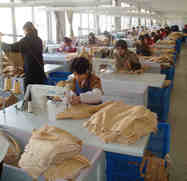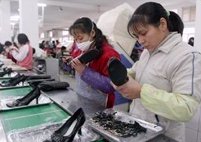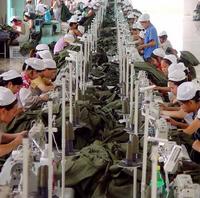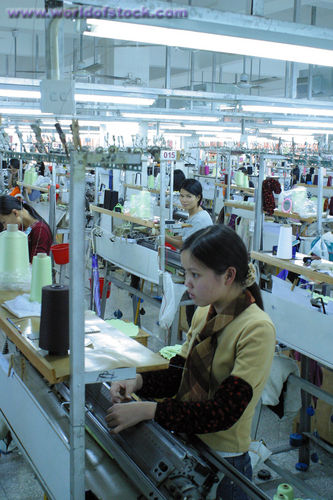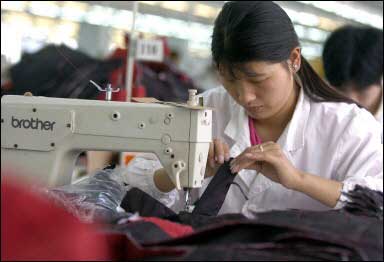 |
||||
|
The Chinese Working Women's NetworkBy Pun Ngai and Yang Lie Ming
IntroductionTHERE IS NO doubt that China is growing rapidly in importance in the global economy. In particular, the United States has seen a marked increase in trade (especially imports from China) and foreign direct investment (U.S. capital going in China). These trends had already begun in the middle to late 1990s, but have increased since Congress granted Permanent Normal Trade Relations status to China in 2000, and since China joined the World Trade Organization in 2001. China has now surpassed the United States as the largest destination in the world for foreign investment. While many U.S. businesses (and other multinationals) look eagerly to both the large Chinese market and the very low wages of Chinese workers, the U.S. labor movement has been focused on stopping the flow of U.S. production and jobs to China. In spring 2004, the AFL-CIO filed a petition with the U.S. Trade Representative, charging that China was enjoying unfair trade advantages that were not allowed under U.S. Trade Law. In particular, the AFL-CIO has asserted that Section 301(d) of the 1974 U.S. Trade Act can and should be used to rectify unfair advantages in trade that China enjoys due to systematic repression of workers rights. Although Section 301(d) it has been used in the past to challenge violations of trade related to intellectual property rights or dumping, it has never been used to file claims based on violation of workers' rights (or "social dumping"). The AFL-CIO petition argues that since China persistently denies workers' freedom of association, encourages forced labor, and does not enforce its own wage, hours and safety laws, China receives a cost-advantage in competing with U.S. firms. The petition calls on the U.S. Trade Representative and President to impose trade remedies, or sanctions, against China, to compensate for this cost advantage. Some critics have argued that while it is true that U.S. firms are moving jobs to China in order to enjoy low wages, the approach of the AFL-CIO is harmful to building worker power. For example, Kent Wong from the UCLA Labor Center writes in New Labor Forum that the AFL-CIO campaign is misguided and misleading on several grounds, and that a better approach to fighting multinational corporations is to develop ties between the U.S. and Chinese labor movements. There is debate among labor activists as to the degree to which it is possible to establish ties with the official Chinese labor movement. On the one hand, the All China Federation of Trade Unions (ACFTU)—the only labor federation in the country—is a wing of the Chinese state. Workers are not allowed to form independent trade unions, and those who try to organize against state-owned enterprises can meet with severe repression. On the other hand, the ACFTU, with 123 million members, is the largest labor organization in the world and—some argue—not monolithic. There are suggestions that there may be room to work within, or at least with, the ACFTU in some places. In particular, there appear to be openings to organize independently around foreign-owned enterprises that have not been traditionally organized by the state-controlled unions. For example, the New York Times reports that the ACFTU has threatened to sue and "blacklist" Wal-Mart and other foreign-owned firms if they don't allow the union to establish branches in their factories. Whether or not there is potential for reform from within the ACFTU, some U.S. unionists have begun to look for opportunities to work with Chinese workers. In March 2004, eight labor educators and labor leaders visited labor scholars, unions and workers in China. That summer, a few U.S. labor activists and unions, including SEIU, CWA and Jobs with Justice, sponsored a tour of two women from the Chinese Working Women's Network (CWWN), formed in 1996, a grassroots organization of migrant women factory workers in Shenzhen, Guandgong Province, China. The two women, Pun Ngai and Yang Lie Ming, traveled around the United States for a month, meeting with activists and sharing their experience organizing in China. The following transcript is based on a talk they gave at the University of Massachusetts-Amherst Labor Center, on September 9, 2004. Pun Ngai is the founder and Chair of CWWN. She also works as a professor at the Hong Kong University of Science and Technology, and is the author of Made in China: Subject, Power and Resistance of Women Workers in a Global Workplace (forthcoming from Duke University Press, 2005). Yang Lie Ming is a migrant laborer who worked in a factory in the Shenzhen economic zone. Four years ago, she became a full-time organizer with CWWN. —Stephanie Luce
TranscriptYang Lie Ming: I worked in a factory for three years, and then as a full-time organizer for this group for four years. I'm very eager to share the stories from our work. Before we left China, I visited a worker in the hospital. He works in a factory that produces for Wal-mart. He fell from very high and injured his head. Pun Ngai: I am the founder of the Chinese Women Workers Network. But now I serve as a volunteer. We have three Hong Kong organizers, and ten mainland organizers. The Hong Kong organizers are university graduates. The mainland organizers are workers who worked in the factories and then become organizers for the Center. Our Center is based in southern China, in the Special Economic Zone set up when China opened its doors to foreign capital in the 1980s. And then in the 1990s, China became open to shops from around the world—all kinds of factories. Now, in southern China you can find all kinds of factories—Reebok, Nike, all the companies. All these companies use subcontracting. They provide jobs to other companies that are operated by Korean capital, Taiwanese capital, and Hong Kong capital. These factories recruit workers from the rural areas.
All of these workers are migrant workers, and they don't have full rights. Under the socialist system, we have a household and registration system that is based on where you are born. If you are born in the countryside, that is where you are allowed to live and work. You do not have the right to move to the city and work there. But when China opened up to the foreign capital, they needed workers from the countryside to work, as cheap labor. For the first time, workers from the countryside were allowed to move. Under this kind of context, all of the workers have to stay in dormitories provided by the company. One hundred percent of these workers are migrants, and 70% are women. That is our task—to organize these migrant women workers. We are not allowed to set up independent trade unions. The labor unions in China are under the umbrella of the ACFTU—the government controlled trade union (All-China Federation of Trade Unions). But that union is not interested in migrant workers. The ACFTU organizes workers in the state-owned enterprises (SOEs), or collective enterprises. Over time, many of these SOEs have become privatized—they are turned into a joint venture with foreign capital. In a few cases, the union has been allowed to stay, but usually at that point, the union is kicked out. Then there is not even a state-controlled union representing these workers working for the factory owned by foreign capital. We come in and try to organize those workers. Our basic organizing model is a community organizing model. We are not trying to establish an independent trade union. Instead, we organize workers in other ways, which Yang Lie Min will talk about.
YLM: We have four areas of focus: 1) legal labor rights; 2) gender awareness; 3) occupational safety and health; 4) alternative economic life, i.e. co-ops. We have an actual Center in the industrial towns—a place where we can hold events. Most of the women workers are young, ages 16 to 25. They miss their families and their home towns, so we build the Worker Center as a home for them. They come here to be together and share their stories. But many women can't come to the Center—they work long hours, and often don't get off work until 10 pm. So we must go to them; we go to the dormitories and visit them there.
We try to establish groups. We start by identifying leaders, and then train those leaders in developing a broad vision, and then on how to build their own networks.
We start by talking to workers about their daily interests—their daily needs. They need hot water, they need a fan—their basic needs. We do a lot of organizing around hot water: the women want hot water to drink, and hot water to wash. If they don't have it in the dormitories, they must go down eight flights of stairs to get it, and back up again. Telephones are another common basic issue, since the women want to be able to call home. So we work to get them together around some of these basic demands. We teach them how to write letters to the managers, how to draw up petitions. When workers make demands and win them, they feel some empowerment. After a year or so we move on to work issues such as overtime pay, and minimum wage compliance. The Chinese labor law is actually quite good, so we work with the women to make sure the employer is following the law. For example, we may make a demand by getting signatures on a petition. We might get one to two thousand signatures. This is possible because one dorm room sometimes has 10-12 workers staying there. We'll send the petition to the manager, but we'll also send it elsewhere: up the corporate ladder, to the trade union, to the Labor Bureau. Once the Labor Bureau is notified they will come in and do an investigation and talk to management. PN: We are pretty successful at winning these cases. This is because Chinese labor law is pretty good, and the violations are so obvious. It is usually too obvious how bad the violations are. In fact, we win about 99% of these. On this tour, we've met with other worker centers in the United States. They told us that they also file these kinds of lawsuits, but usually only win about 50% of the time. For us, the main challenge is getting workers to understand their rights and then be willing to pursue the case. YLM: We now have 16 dormitory networks. Some of those are small, with 15-20 workers, but some have 100 workers. In addition to the physical Worker Center and the dorm networks, we also work through our mobile van. We use the van to drive around and talk to workers on their dinner breaks, or when they are coming home from work. The van works from 5 pm to around 10:30 pm. We drive around and talk to workers and give trainings: how to prevent sexual harassment in the workplace, safety and health issues, what to do if they are injured, what to do if they are pregnant. We talk to about 200-300 workers per night through this work. On the van, we have a big screen television, stereo system, and a small library.
Injury CompensationWe also use the van to do organizing with injured workers. We take the van to the hospital and meet with workers there. It is very common to get injuries on the job, especially for those workers who do not get enough rest and are working under a lot of strain. Workers work 12-16 hours per day. Also, there are a lot of old machines that are brought in from Korea or Hong Kong. With the older machines the incidence of injury can go up.
|
|
|||
|
|
||||
|
We develop networks in the hospital and help workers find out how to get compensation for their injuries. The process is very complicated, involving many steps. If you work for an employer who had insurance, and you are successful in your efforts, you might get 2,000 U.S. dollars for your injury. But if you had not been working for an insured employer, you can still try to sue to get compensation. This can take a long time.
Since we don't have money for full-time organizers we rely heavily on volunteers. Some of the injured workers have volunteered to help in this work. They made their own newsletter to use with workers, to show them the steps involved in fighting for compensation. The last area of work is our co-op. This is a consumer co-op connected to the dorm and the hospital. When workers get fired for being too militant we can bring them in to work for the co-op. There are too many injured workers, so we can't bring them all in, but some of them do work there. PN: We are using a community organizing model, but we are moving to a factory based model as well. We think that there is a possibility of working further at the factory level by waging campaigns against the brand name. Many large companies have their own corporate code of conduct. We can move in and establish a worker committee that monitors how well the company is complying with their code. We can also use the committees to monitor compliance with national labor law. We do not call for boycotts of products. Instead, we try to work with the anti-sweatshop groups and with our committees to improve conditions of work.
Fight for WagesWe often hear that the subcontractors running the factory do not make enough money. It is true that factory owners have seen prices go down in the last ten years. But we know they are still earning a lot. We know there is money there in the system. Some say the bulk of profits go to the retailer, some say the bulk of profits are with the factory owner. For us, it doesn't really matter where the money is—we just demand higher wages. And if the brand name company or retailer has a company code of conduct, they should provide the resources needed to make sure it's enforced. That might mean giving more money to the factory owner. The factory owner must get more money from the retailer so that they can comply with the code of conduct and pay higher wages. We can do this because the Chinese government allows us to organize against foreign capital. We aren't allowed to organize against state-owned enterprises, but the workplaces we are organizing in are owned by foreign capital. There is sometimes retaliation from the employer, and some from the local government. But for the most part we are seen as social workers and not treated as a hostile force. [QUESTION: Can you talk a bit more about the working conditions in the factories?] YLM: As for working conditions, the wages are very low. We get about $2 U.S. for 12 hours of work. China does have a minimum wage, which is only about $60 U.S. per month. But you usually have to work overtime to reach the minimum wage. We have no sick leave. We do get holidays off—we get to take off five to seven days off for the Chinese New Year. This is important because it's usually the only chance we have to go to our homes in the countryside. Otherwise, we get very little time off—sometimes only one or two days per month. [QUESTION: Are workers afraid that if they organize, employers will just pick up and move elsewhere?] YLM: Employers do make threats that they will move if we organize for higher wages. But that is already happening. Employers are already closing some plants in Shenzhen and moving to new regions of China. But the workforce here is already mobile. We are migrants. Migrant workers can follow the work. It is not as if workers can enjoy the city life anyway, since they are stuck working and live in the dormitories. [QUESTION: Do you work with the official unions?] PN: We have to work with the official unions. For the van, we work with the hospital union; for the university, we work with the union there. These are official unions connected with the official ACFTU. [QUESTION: What happens to the women after they leave the factories? And what do the women do with their wages?] PN: A lot of dorm workers send money back home. In fact, you can see a lot of new construction going on in the home towns, as people use the money to build new houses. After that, the money is used to pay for a son's education. But over the past 20 years of this, we've seen some of the women become more independent. Ten years ago, they would send 80% of their wages home. Now, they send maybe only 50% home. They are keeping more for their own consumption, to buy small things for themselves. Women are usually pushed out of the work force around age 25. Most then go back to the rural areas to get married. They can only stay in the cities if they marry someone born in the city, but most city men would not marry a rural woman so probably 95% of the women workers return to the countryside. What they end up doing depends on who they marry. If the husband is very poor, they may end up both coming back to try to find work in the factories.
|
||||
 |
|
 |
||
